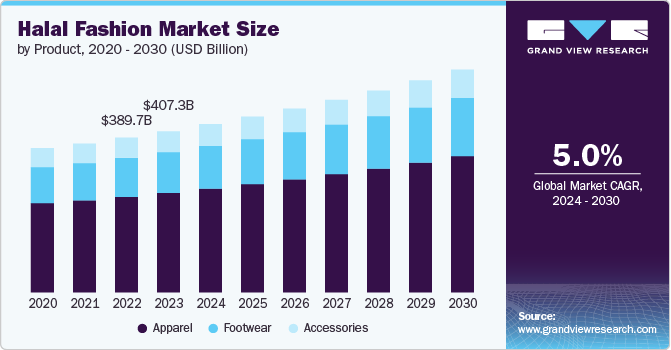Halal Fashion Market Boosted by Innovation in Fabric and Design Choices

The global halal fashion market size was estimated at USD 407,285.2 million in 2023 and is projected to reach USD 571,412.6 million by 2030, expanding at a CAGR of 5% from 2024 to 2030. This growth is largely fueled by rising religious and cultural consciousness among Muslim communities.
A growing number of individuals are choosing to align their lifestyle—including clothing choices—with their faith. Halal fashion, which adheres to Islamic principles of modesty and ethical practices, enables Muslims to express their identity while maintaining spiritual integrity. This increased commitment to religious values continues to drive demand for apparel that conforms to halal standards, providing both spiritual fulfillment and authenticity.
The halal fashion landscape is also undergoing significant transformation, marked by the fusion of modesty with contemporary style. Modern halal fashion now extends well beyond traditional garments to include diverse, fashionable apparel. Designers are integrating modern fashion trends with modest principles, making halal fashion more appealing, especially among younger consumers and style-conscious individuals who seek a balance between their beliefs and personal aesthetics.
Social media has emerged as a powerful catalyst in this market, with Muslim fashion influencers and bloggers showcasing the versatility of modest fashion. These digital personalities have played a critical role in mainstreaming halal fashion by demonstrating that it can be both trendy and faith-aligned. Their content not only boosts brand visibility but also inspires consumers to embrace halal fashion as a stylish choice.
In addition, a broader global shift toward ethical and sustainable consumption is positively impacting the halal fashion industry. Many halal brands place emphasis on ethical sourcing, sustainable practices, and fair trade—values that resonate with environmentally and socially conscious consumers. This convergence of religious, ethical, and environmental values is amplifying the appeal of halal fashion across a broader demographic.
For example, in June 2022, Lululemon—a well-known athletic apparel and footwear company—introduced a line of workout hijabs tailored for active Muslim women. This debut range includes the Lightweight Performance Hijab and the Scarf-Style Hijab, available in select colors and sizes. These hijabs were designed in consultation with hijab wearers and feature practical elements like pinless wear, pull-on styling, and adjustable toggles, demonstrating how brands are adapting to meet the specific needs of this market.
Order a free sample PDF of the Halal Fashion Market Intelligence Study, published by Grand View Research.
Key Market Trends & Insights
- Regionally, Asia Pacific emerged as the top revenue-generating market in 2023.
- By segment, apparel dominated the halal fashion landscape, contributing USD 407,285.2 million in revenue in 2023.
- Apparel remains the fastest-growing and most lucrative product category through the forecast period.
Market Size & Forecast
- 2023 Market Size: USD 407,285.2 Million
- 2030 Projected Market Size: USD 571,412.6 Million
- CAGR (2024–2030): 5%
Key Halal Fashion Company Insights
The halal fashion market is highly dynamic, driven by innovation, evolving consumer demands, and regional production strengths. Leading brands are enhancing their competitive edge through R&D, cost-efficient manufacturing, and quality assurance. Strategic moves such as partnerships, mergers, and regional expansions are common. Moreover, companies are increasing efforts to educate consumers about product compliance and ingredient transparency while aligning with global regulatory standards.
Major Players in the Halal Fashion Market:
- Aab Collection
- Modanisa
- Haute Hijab
- SUKAINA
- An-Nahar
- Dolce & Gabbana
- Inayah
- SHUKR Islamic Clothing
- Haf & Haf
- The WRDS Clothing
Browse Horizon Databook for Global Halal Fashion Market Size & Outlook
Conclusion
The halal fashion market is experiencing sustained growth, supported by a convergence of religious observance, fashion-forward innovation, and ethical consumerism. The increasing availability of stylish, modest, and ethically produced clothing is not only meeting the needs of faith-based consumers but also attracting a broader audience. As more global brands and designers enter this space with inclusive and sustainable offerings, the halal fashion industry is poised to continue expanding its cultural and commercial influence in the years ahead.
- Art
- Causes
- Crafts
- Dance
- Drinks
- Film
- Fitness
- Food
- Games
- Gardening
- Health
- Home
- Literature
- Music
- Networking
- Other
- Party
- Religion
- Shopping
- Sports
- Theater
- Wellness


